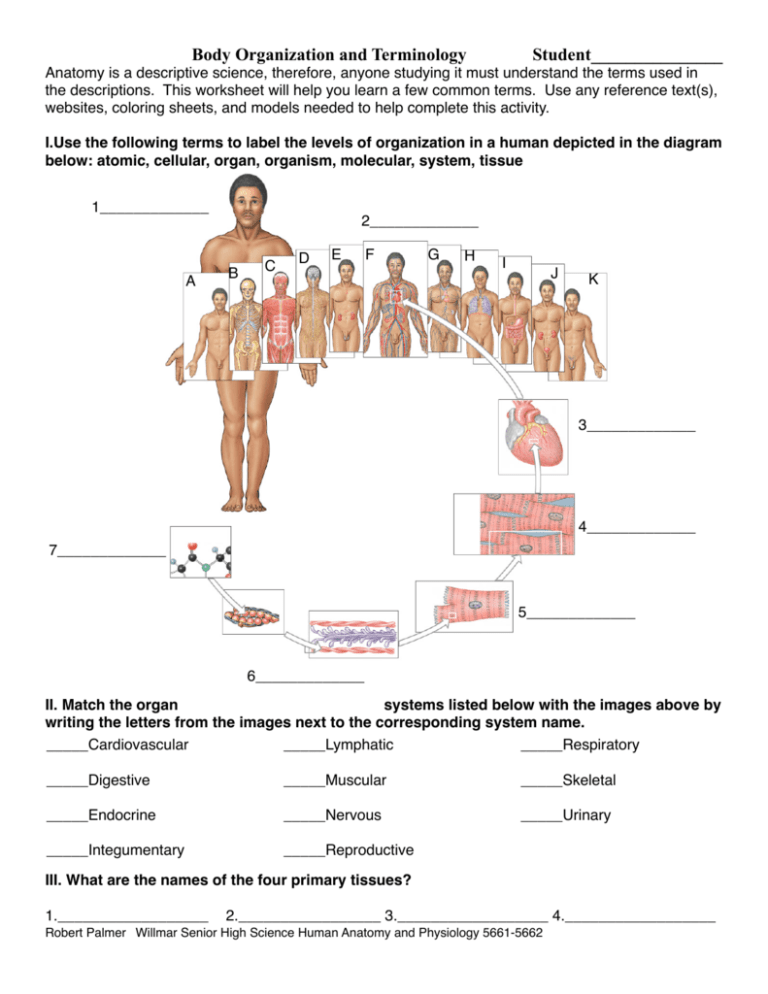Organization and terminology
advertisement

Body Organization and Terminology Student_______________ Anatomy is a descriptive science, therefore, anyone studying it must understand the terms used in the descriptions. This worksheet will help you learn a few common terms. Use any reference text(s), websites, coloring sheets, and models needed to help complete this activity. I.Use the following terms to label the levels of organization in a human depicted in the diagram below: atomic, cellular, organ, organism, molecular, system, tissue 1_____________ A 2_____________ B C D E F G H I J K 3_____________ 4_____________ 7_____________ 5_____________ 6_____________ II. Match the organ systems listed below with the images above by writing the letters from the images next to the corresponding system name. _____Cardiovascular _____Lymphatic _____Respiratory _____Digestive _____Muscular _____Skeletal _____Endocrine _____Nervous _____Urinary _____Integumentary _____Reproductive III. What are the names of the four primary tissues? 1.__________________ 2._________________ 3.__________________ 4.__________________ Robert Palmer Willmar Senior High Science Human Anatomy and Physiology 5661-5662 Body Organization and Terminology Student_______________ IV. Discuss at least one example of how several organ systems work together to perform a necessary life function. V. Define homeostasis: VI. What role does negative feedback play in homeostasis? VII. Stand in the anatomical position. Describe it. VIII.Write in the definition of each directional term listed below. Superior (cranial, cephalic): Inferior (caudal): Anterior (ventral): Posterior (dorsal): Medial: Lateral: Internal (deep): External (superficial): Proximal: Distal: Visceral: Parietal: Intermediate: Robert Palmer Willmar Senior High Science Human Anatomy and Physiology 5661-5662 Body Organization and Terminology Student_______________ IX. Complete the following statements by writing the correct directional term. a. The thorax is __________ to the abdomen. k. The wrist is __________ to the hand. b. The heart is __________ to the lungs. l. The breastbone is __________ to the spine. c. The hand is __________ to the elbow. m. The brain is __________ to the spinal cord. d. The navel is on the __________ surface. n.The lungs are __________ to the stomach. e. The skin is __________ to the muscles. o.The thumb is __________ to the other digits. f. The legs are __________ to the trunk. p.The heart is __________ to the sternum. g. The buttocks are __________ to the pelvis. q. The diaphragm is __________ to the thorax. h. The ears are on the __________ surface. r. The elbow is on the __________ end of the humerus. s.The hip is on the _________ end of the femur. i. The knee is __________ to the foot. j. The brain is __________ to the cranium. t. The inside thigh is called the ___________ aspect of the femoral region. X. Fill in the blanks with the correct term identifying each body region from the figure below. Robert Palmer Willmar Senior High Science Human Anatomy and Physiology 5661-5662 Body Organization and Terminology Student_______________ XI. Correctly label the three planes of dissection by writing the corresponding letter. frontal (coronal) _____ median (sagittal) _____ transverse (cross) _____ XII. Identify the plane that would be needed to show the following: I. The structural relationship between the muscles and bones in the middle of the forearm _________ 2. The three cavities of the thorax _____________ 3. The structural arrangement of the bladder, rectum, and reproductive organs in the pelvic cavity ___ 4. The layer and relative thicknesses of the wall of the intestine ____________ 5. The structure of the bony plate (nasal septum) that separates the nasal cavity into two parts _____ XIII. Provide the anatomical term for each of the common terms or regions listed below. Skull __________________________ Armpit __________________________ Shoulder blade_________________________ Back of knee_________________________ Surface of hand __________________________ Hand __________________________ Surface of foot __________________________ Arm __________________________ Small of back __________________________ Upper leg __________________________ Navel __________________________ Neck __________________________ Robert Palmer Willmar Senior High Science Human Anatomy and Physiology 5661-5662 Body Organization and Terminology Student_______________ XIV. Fill in the blanks with the correct term identifying each body cavity in the figures below. Robert Palmer Willmar Senior High Science Human Anatomy and Physiology 5661-5662 Body Organization and Terminology Student_______________ XV. Identify the body cavity in which each of the following organs is found and identify the body system to which the organ belongs. Organ Cavity System Spinal cord Heart Lung Liver Uterine tube Small intestine Brain Spleen XVI. Fill in the blanks with the correct term identifying each abdominal region in the figures below. Robert Palmer Willmar Senior High Science Human Anatomy and Physiology 5661-5662







